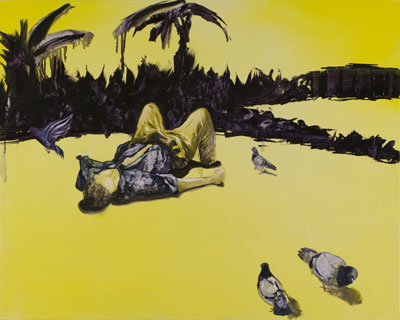| EXHIBITIONS NEWS PRESS ABOUT US CONTACT |
|||||
| REPRESENTED ARTISTS | BERTILLE BAK | GWENAEL BELANGER | DEXTER DYMOKE | ANTTI LAITINEN | |
| MARKO MAETAMM | YUDI NOOR | OLIVER PIETSCH | KIM RUGG | ||
| BETTINA SAMSON | SINTA WERNER | ||||
MIKE
NEWTON
My Private Idaho
15
FEBRUARY– 16 MARCH
VIEW
WORK
NETTIE HORN is pleased to present My Private Idaho, a solo exhibition of new works by British painter Mike Newton. Newton’s evocative scenes stem from drawings, photographs and found objects coming together to create emotive and narrative images often addressing themes of melancholia and nostalgia. In his new body of work Newton uses the reclining figure as the subject in his large scale canvases, each depicting someone overwhelmed by excessive daytime sleepiness. For Newton, sleep is suggestive of a temporary death and is associated with an early childhood memory of finding a dead animal and being told by his parents that it was simply asleep, not dead.
|
This theme was brought into focus by the River Phoenix character in Gus Van Sant’s film “My Private Idaho” which follows and explores the journey of a narcoleptic and which is loosely based on Shakespeare’s Henry IV, who falls asleep as a defence mechanism when his thoughts turn to memories of his lost mother. The film is referenced most
directly in the haunting painting Falstaff in which hooded figures
loom over a sleeping form, all set against a background of Episcopal
purple. Whether the hooded figures are threatening or simply intrigued
Newton’s work dwells on the bleak realities of modern society
and reference his own experience as a teenager, which he recalls
as a time suspended, waiting for something to happen. Exploring
issues of memory and loss, Newton recalls and reinvents specific
half remembered scenes with issues of ennui, ritual, role-play,
stereotypes and confusion about identity concurrently playing
a part. |
Painting directly onto the canvas, Newton works from a number of preparatory oil studies and combines transparent oils in traditional glazes which are applied with loose immediate brushstrokes on a highly reflective ground. “I wish it was the Sixties...” is typical of this lively approach and the resulting image is evocative of a backlit transparency which references the idea of a projected film. Newton’s use of colour and the luminosity of his paint are often borrowed from films and the palette in each of the exhibited paintings is sampled from stills of the Gus Van Sant’s movie - using colour combinations and acidic tones to create an unsettling and unnerving mood. Victor Hugo defined melancholy as the pleasure of being sad and Newton clearly takes pleasure in exploring this emotional state in his painting which, through historical painting references and an evident cinematic influence, is surrounded by the halo of the sublime.
© NETTIE HORN
